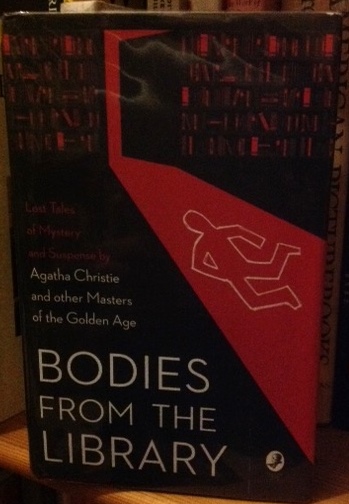Inspiring Older Readers
 posted on 29 Nov 2020
posted on 29 Nov 2020
Bodies from the Library edited by Tony Medawar
“The golden age of detective fiction, which took place roughly in the twenties and thirties, left behind an enduring legacy which continues to shape the crime genre today. The classic whodunnit of the golden age – typically involving the investigation of a suspicious murder in an enclosed scenario, such as an English country house – is still a popular literary sub-genre.” (Bridget Coulter – Off the Shelf Blog)
Bodies from the Library is the first of what is currently three (soon to become four) volumes of short stories from writers of The Golden Age – some famous, some not so famous names – that have been ‘lost’ or ‘forgotten’ over the years. All of these stories have either only been published once before ‘in a newspaper, a rare magazine or an obscure collection – or have never been published until now.’
The collection has been brought together by Tony Medawar who also provides an excellent introduction that gives the reader an outline of the history of this Golden Age writing as well the important role newspapers had in printing these stories that were considered essentially ephemeral. In fact, the introduction is stronger than a number of the fictional contributions included here – some of which seem to me to test the boundaries of what might be considered a detective mystery. The contribution from Agatha Christie, The Wife of the Kenite, is a good example of this. Her story was first published in an obscure Australian magazine and would more accurately be described as a spy thriller than as a murder mystery. The same could be said of the Georgette Heyer piece, Linckes’ Great Case which was first published in 1923 and reflects some of the political paranoia of the time relating to inter-governmental espionage.
Golden Age detective fiction can be seen as a genre because in broad terms it abided by a set of ‘rules’ or guidelines that formed a sort of pact with the reader. These conventions were effectively codified by the vicar-cum-literary critic, Ronald Knox in 1929 when he claimed:
“( a story ) must have as its main interest the unravelling of a mystery; a mystery whose elements are clearly presented to the reader at an early stage in the proceedings, and whose nature is such as to arouse curiosity, a curiosity which is gratified at the end.”
In "Detective Story Decalogue” (1939) he also set out ten rules to abide by:
- The criminal must be mentioned in the early part of the story, but must not be anyone whose thoughts the reader has been allowed to know.
- All supernatural or preternatural agencies are ruled out as a matter of course.
- Not more than one secret room or passage is allowable.
- No hitherto undiscovered poisons may be used, nor any appliance which will need a long scientific explanation at the end.
- No Chinaman must figure in the story.
- No accident must ever help the detective, nor must he ever have an unaccountable intuition which proves to be right.
- The detective himself must not commit the crime.
- The detective is bound to declare any clues which he may discover.
- The "sidekick" of the detective, the Watson, must not conceal from the reader any thoughts which pass through his mind: his intelligence must be slightly, but very slightly, below that of the average reader.
- Twin brothers, and doubles generally, must not appear unless we have been duly prepared for them.
Many of the stories included in this collection demonstrate both the strengths and weaknesses of a genre that has one eye on a set of ‘rules’ in this this way. There’s a predictable, reassuring shape to the way the story proceeds and the persistence of puzzlement or mystery depends on the skill of the writer to sustain it within the permitted boundaries. The problem is that this makes many of the stories less of a mystery and more an exposition of a mystery most alert readers will already have worked out. The stories put more of an emphasis on exposition than on keeping the reader on the hop.
I must say, however, this series of books are brilliantly and beautifully packaged and make a really delightful contribution to any library of crime that you’re thinking of building up.
Terry Potter
November 2020